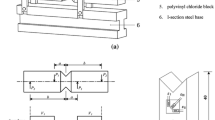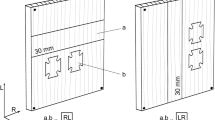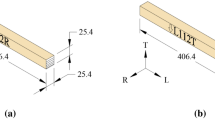Abstract
The increasing demand and widespread utility of wood composite products necessitate the knowledge of the orthotropic engineering and strength properties of the raw wood used for its safe design and effective performance. This research study aimed at finding the orthotropic elastic parameters of a sustainable timber in India, namely rubber wood (Hevea brasiliensis) with respect to the material axes longitudinal (L), radial (R) and tangential (T), which is a potential raw material for laminated products as verified. This study evaluated the three Young’s moduli, the three shear moduli and the six Poisson’s ratios of the wood species, unavailable in literature. Compression test in rectangular prism was used for the determination of the Young’s moduli and Poisson’s ratios. Shear characterization in the three material planes was done using the Iosipescu test. The highest value of normal stiffness of the material in compression was obtained in the longitudinal direction followed by radial stiffness and tangential stiffness. The shear stiffness was largest in the LR plane followed by LT and RT planes. RT plane exhibited the highest Poisson’s ratio and TL plane the lowest. Significant difference was noted in the shear strength of LR planes between block shear test and Iosipescu test but not with the LT planes.











Similar content being viewed by others
References
American Society for Testing and Materials (1989) Standard method of test for shear modulus of wood. D 3044-76, ASTM International, USA
American Society for Testing and Materials (1999) Standard test method for shear properties of composite materials by the v-notched beam method. D5379/D 5379M-98, ASTM International, USA
American Society for Testing and Materials (2002) Standard test method for compressive properties of rigid plastics. D 695-02a, ASTM International, USA
American Society for Testing and Materials (2009) Standard test methods for small clear specimens of timber. D 143-09, ASTM International, USA
Bodig J, Jayne BA (1982) Mechanics of wood and wood composites. Van Nostrand Reinhold, New York
Bucur V (2006) Acoustics of wood. Springer, Germany
Bucur V, Archer RR (1984) Elastic constants for wood by an ultrasonic method. Wood Sci Techno 18:255–265
Bucur V, Declercq NF (2006) The anisotropy of biological composites studied with ultrasonic technique. Ultrasonics 44:e829–e831
Cowin SC (1979) On the strength anisotropy of bone and wood. J Appl Mech 46(12):832–838
Dahl KB, Malo KA (2009) Linear shear properties of spruce softwood. Wood Sci Technol 43:499–525
Feeney FE, Chivers RC, Evertsen JA, Keating J (1998) The influence of inhomogeneity on the propagation of ultrasound in wood. Ultrasonics 36:449–453
Goncalves R, Trinca AJ, Cerri DGP (2011) Comparison of elastic constants of wood determined by ultrasonic wave propagation and static compression testing. Wood Fiber Sci 43(1):64–75
Hankinson RL (1921) Investigation of crushing strength of spruce at varying angles of grain. Air service information circular No. 259, U.S. Air service
Hasegawa M, Takata M, Matsumura J, Oda K (2011) Effect of wood properties on within—tree variation in ultrasonic wave velocity in softwood. Ultrasonics 51:296–302
Hering S, Keunecke D, Niemz P (2012) Moisture dependent orthotropic elasticity on beech wood. Wood Sci Technol 46(5):927–983
Ho H, Tsai MY, Morton J, Farley GL (1993) Numerical analysis of the Iosipescu specimen for composite materials. Compos Sci Technol 46(2):115–128
Janowiak JJ, Pellerin RF (1992) Shear moduli determination using torsional stiffness measurements. Wood Fiber Sci 24(4):392–400
Jones RM (1975) Mechanics of composite materials. McGraw-Hill, Kogakusha
Keunecke D (2008) Elasto-mechanical characterisation of yew and spruce wood with regard to structure-property relationships. Dissertation, Institute for Building Materials, ETH Zurich
Keunecke D, Sonderegger W, Pereteanu K, Luthi T, Niemz P (2007) Determinations of young’s and shear moduli of common yew and Norway spruce by means of ultrasonic waves. Wood Sci Technol 41:309–327
Keunecke D, Hering S, Niemz P (2008) Three dimensional elastic behavior of common yew and Norway spruce. Wood Sci Technol 42:633–647
Lang EM, Bejo L, Szalai J, Kovacs Z (2000) Orthotropic strength and elasticity of hardwoods in relation to composite manufacture. Part I. Orthotropy of shear strength. Wood Fiber Sci 32(4):502–519
Lempriere BM (1968) Poisson’s ratio in orthotropic materials. AIAA Journal 6(11):2226–2227
Liu JY (2002) Analysis of off-axis tension of wood specimens. Wood Fiber Sci 34(2):205–211
Liyu W, Zhenyou L (2004) Twelve elastic constants of Betula platyphylla Suk. Fores Stud China 6(1):37–41
Mascia NT, Vanalli L (2012) Evaluation of the coefficients of mutual influence of wood through off-axis compression tests. Constr Build Mater 30:522–528
Nadir Y, Nagarajan P (2014) The behavior of horizontally glued laminated beams using rubber wood. Constr Build Mater 55:398–405
Ozyhar T (2013) Moisture and time-dependent orthotropic mechanical characterization of beech wood. Dissertation, Institute for Building Materials, ETH Zurich
Ozyhar T, Hering S, Niemz P (2012) Moisture-dependent elastic and strength anisotropy of European beech wood in tension. J Mater Sci 47(16):6141–6150
Ozyhar T, Hering S, Sanabria SJ, Niemz P (2013) Determining moisture-dependent elastic characteristics of beech wood by means of ultrasonic waves. Wood Sci Technol 47(2):329–341
Pagnotta L (2008) Recent progress in identification methods for the elastic characterization of materials. Int J Mech 4(2):129–140
Samson M, Sotomayor-Castellanos JR (1991) Constant bending method for determining modulus of elasticity of lumber in structural size. Wood Fiber Sci 23(4):520–532
Sliker A, Yu Y (1993) Elastic constants for hardwoods measured from plate and tension tests. Wood Fiber Sci 25(1):8–22
Sliker A, Yu Y, Weigel T, Zhang W (1994) Orthotropic elastic constants for eastern hardwood species. Wood Fiber Sci 26(1):107–121
Sretenovic A, Muller U, Gindl W, Teischinger A (2004) New shear assay for the simultaneous determination of shear strength and shear modulus in solid wood: finite element modeling and experimental results. Wood Fiber Sci 36(3):302–310
Szalai J (1992) Indirect determination of shearing strength of wood using the anisotropic strength theory (in German). Holz Roh- Werkst 50:233–238
Szalai J (1994) Anisotropic strength and elasticity of wood and wood based composites (in Hungarian), Private edn. Sopron, Hungary
Xavier JC, Garrido NM, Oliveira M, Morais JL, Camanho PP, Pierron F (2004) A comparison between the Iosipescu and off-axis shear test method for the characterization of Pinus Pinaster Ait. Compos A 35:827–840
Yoshihara H, Matsumoto A (2005) Measurement of the shearing properties of wood by in-plane shear test using a thin specimen. Wood Sci Technol 39:141–153
Yoshihara H, Ohsaki H, Kubojima Y, Ohta M (2001) Comparisons of shear stress/shear strain relations of wood obtained by Iosipescu and torsion tests. Wood Fiber Sci 33(2):275–283
Youngs RL (1957) The perpendicular-to-grain mechanical properties of red oak as related to temperature, moisture content and time. Science 16(4):567–574
Zhang W, Sliker A (1991) Measuring shear moduli in wood with small tension and compression samples. Wood Fiber Sci 23(1):58–68
Acknowledgments
The authors express sincere gratitude for the permission and the genuine support rendered by Rakesh S, Deputy Director, Composites Entity (CMSE), Vikram Sarabhai Space Centre, ISRO, Thiruvananthapuram. The appreciation is extended to V. J. James, head of the testing division, CMSE and all the staff of the testing division for their great support and sharing their valuable time for this research study.
Author information
Authors and Affiliations
Corresponding author
Rights and permissions
About this article
Cite this article
Nadir, Y., Nagarajan, P. & Midhun, A.J. Measuring elastic constants of Hevea brasiliensis using compression and Iosipescu shear test. Eur. J. Wood Prod. 72, 749–758 (2014). https://doi.org/10.1007/s00107-014-0842-4
Received:
Published:
Issue Date:
DOI: https://doi.org/10.1007/s00107-014-0842-4




